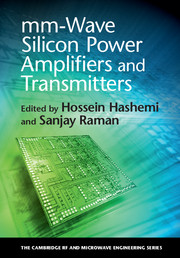Book contents
- Frontmatter
- Contents
- List of Contributors
- Preface
- 1 Introduction
- 2 Characteristics, performance, modeling, and reliability of SiGe HBT technologies for mm-wave power amplifiers
- 3 Characteristics, performance, modeling, and reliability of CMOS technologies for mm-wave power amplifiers
- 4 Linear-mode mm-wave silicon power amplifiers
- 5 Switch-mode mm-wave silicon power amplifiers
- 6 Stacked-transistor mm-wave power amplifiers
- 7 On-chip power-combining techniques for mm-wave silicon power amplifiers
- 8 Outphasing mm-wave silicon transmitters
- 9 Digital mm-wave silicon transmitters
- 10 System-on-a-chip mm-wave silicon transmitters
- 11 Self-healing for silicon-based mm-wave power amplifiers
- Index
- References
8 - Outphasing mm-wave silicon transmitters
Published online by Cambridge University Press: 05 April 2016
- Frontmatter
- Contents
- List of Contributors
- Preface
- 1 Introduction
- 2 Characteristics, performance, modeling, and reliability of SiGe HBT technologies for mm-wave power amplifiers
- 3 Characteristics, performance, modeling, and reliability of CMOS technologies for mm-wave power amplifiers
- 4 Linear-mode mm-wave silicon power amplifiers
- 5 Switch-mode mm-wave silicon power amplifiers
- 6 Stacked-transistor mm-wave power amplifiers
- 7 On-chip power-combining techniques for mm-wave silicon power amplifiers
- 8 Outphasing mm-wave silicon transmitters
- 9 Digital mm-wave silicon transmitters
- 10 System-on-a-chip mm-wave silicon transmitters
- 11 Self-healing for silicon-based mm-wave power amplifiers
- Index
- References
Summary
Introduction
Efficiency enhancement and linearization techniques are always the focus of research in power amplifier (PA) design. As the last building block of the transmitter (TX) and the most power-hungry one, the PA has to maintain sufficient linearity to ensure the signal integrity and achieves high efficiency for low power. The conventional TX based on I/Q modulation has variable envelopes in both I and Q paths. It needs to operate at 3–6 dB back-off from the 1-dB compression point (P1dB) depending on the applied modulation for linearity, which inevitably results in low average efficiency. Digital pre-distortion (DPD) has been proposed to correct the AM–AM and AM–PM distortions of the PA by a closed feedback loop [1]. However, the loop stability is usually difficult to ensure, especially for wideband signals. The reported improvement of DPD is limited to approximately 1–2 dB in P1dB and 3%–5% in PAE[1]. The polar modulation (or envelope elimination and restoration) [2] separates the envelope and phase components so that the phase information can be amplified by the highly efficient switching amplifier. The envelope modulator operates at relatively low speed (on the order of the modulation bandwidth) and thus consumes low power. It will modulate the supply of the switching amplifier and restore the amplitude modulation at PA output. The potential challenges of a polar transmitter for high-speed communication are to design an efficient wideband envelope modulator and balance the delay between the envelope and phase paths. The Doherty PA [3] is another efficiency-enhancement technique. It can maintain high efficiency over a broad power range by combining the outputs of a class-AB PA (main amplifier) and a class-C PA (auxiliary amplifier). The issue here is that the main amplifier stays in deep saturation at high power level. Although the gain saturation of the main amplifier can be compensated by the gain expansion of the auxiliary amplifier. The compensation in phase distortion is rather difficult to predict and sensitive to the bias current. Besides, the main and auxiliary paths are very unbalanced, potentially causing problems for high-speed (i.e. Gb/s) communication.
Outphasing has become one of the most popular techniques in the past five years [4– 6]. In outphasing, the linear amplification is achieved by vector summing the outputs of two identical branch PAs.
- Type
- Chapter
- Information
- mm-Wave Silicon Power Amplifiers and Transmitters , pp. 302 - 333Publisher: Cambridge University PressPrint publication year: 2016

